oil Citroen BERLINGO MULTISPACE RHD 2015 2.G Owner's Manual
[x] Cancel search | Manufacturer: CITROEN, Model Year: 2015, Model line: BERLINGO MULTISPACE RHD, Model: Citroen BERLINGO MULTISPACE RHD 2015 2.GPages: 276, PDF Size: 12.21 MB
Page 14 of 276
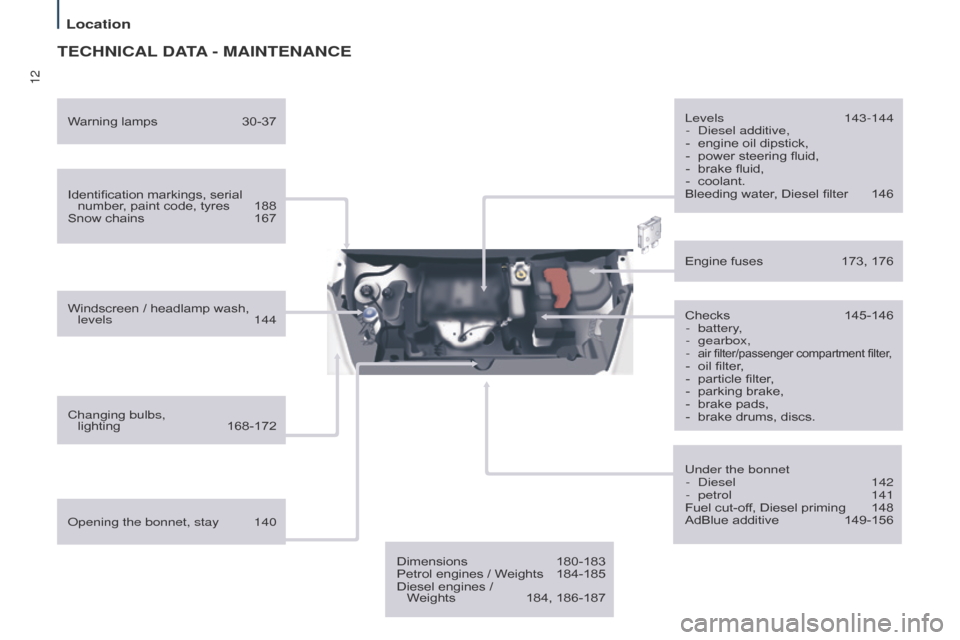
12
Berlingo_2_VP_en_Chap01_vue-ensemble_ed02-2014
tEcHnIcAL dAtA - MAI nt E n A nc E
Identification markings, serial number
, paint code, tyres 188
Snow
chains
167
Windscreen
/ headlamp wash,
levels
144
Changing bulbs,
lighting
168-172 Checks
145-146
-
battery
,
-
gearbox,
-
air filter/passenger compartment filter,- oil filter,
- particle filter,
-
parking
brake,
-
brake
pads,
-
brake
drums, discs.
Engine
fuses
173,
176
o
pening the bonnet, stay
140 Levels
143-144
-
d iesel additive,
-
engine
oil dipstick,
-
power
steering fluid,
-
brake
fluid,
-
coolant.
Bleeding
water, Diesel filter
146
W
arning
lamps
30-37
Under the bonnet-
d iesel
142
-
petrol
141
Fuel
cut-off, Diesel priming
148
AdBlue
additive
149-156
Dimensions
180-183
Petrol
engines
/
Weights
184-185
Diesel
engines
/
Weights
184,
186-187
Location
Page 17 of 276
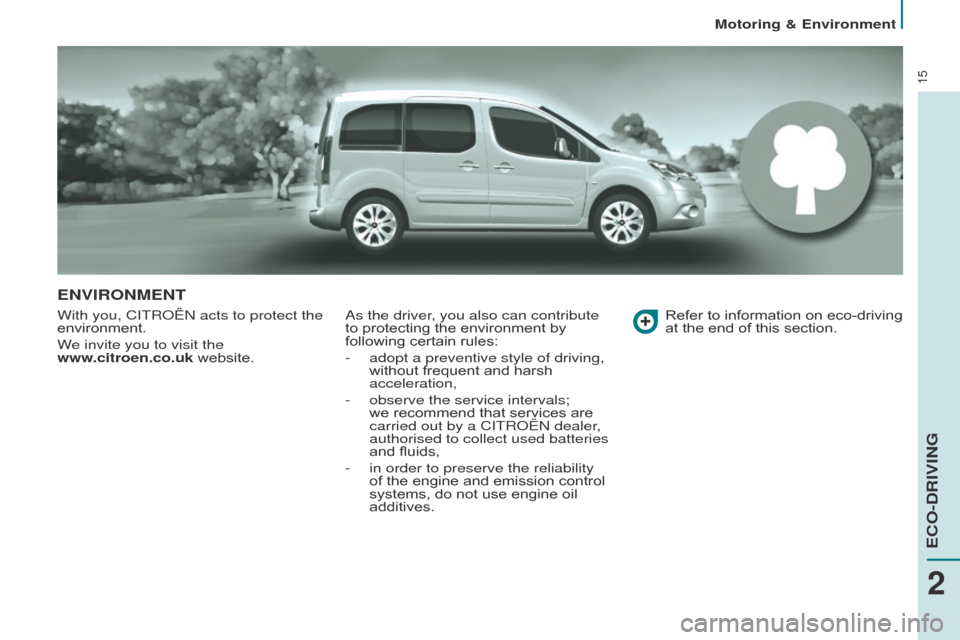
15
EnVIrOnMEnt
With you, CITRoËn acts to protect the
environment.
W
e invite you to visit the
www.citroen.co.uk
website.a s the driver, you also can contribute
to protecting the environment by
following
certain rules:
-
adopt a preventive style of driving,
without
frequent and harsh
acceleration,
-
observe the service intervals;
we
recommend that services are
carried out by a CITR
o Ë n dealer,
authorised to collect used batteries
and
fluids,
-
in order to preserve the reliability
of
the engine and emission control
systems,
do not use engine oil
additives.Refer
to information on eco-driving at
the end of this section.
2
ECo-dRIVInG
Motoring & Environment
Page 19 of 276
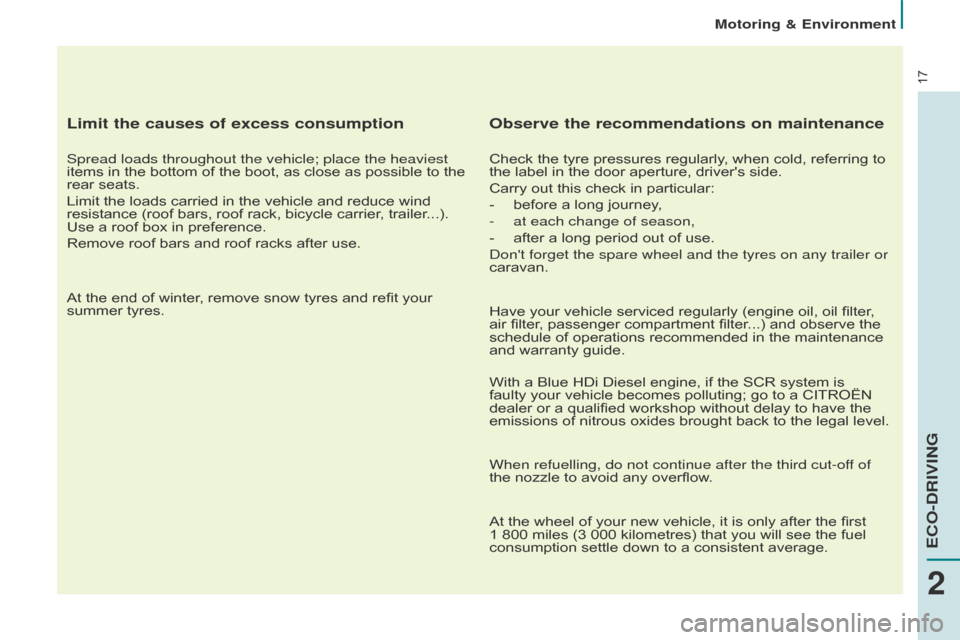
17
Limit the causes of excess consumption
Spread loads throughout the vehicle; place the heaviest
items in the bottom of the boot, as close as possible to the
rear
seats.
Limit
the loads carried in the vehicle and reduce wind
resistance
(roof bars, roof rack, bicycle carrier, trailer...).
Use
a roof box in preference.
Remove
roof bars and roof racks after use.
At
the end of winter, remove snow tyres and refit your
summer
tyres.
Observe the recommendations on maintenance
Check the tyre pressures regularly, when cold, referring to the label in the door aperture, driver's side.
Carry
out this check in particular:
-
before
a long journey,
-
at each change of season,
-
after
a long period out of use.
d
on't forget the spare wheel and the tyres on any trailer or
caravan.
Have
your vehicle serviced regularly (engine oil, oil filter,
air
filter, passenger compartment filter...) and observe the
schedule
of operations recommended in the maintenance
and
warranty guide.
With
a Blue HDi Diesel engine, if the SCR system is
faulty
your vehicle becomes polluting; go to a CITROËN
dealer
or a qualified workshop without delay to have the
emissions
of nitrous oxides brought back to the legal level.
When refuelling, do not continue after the third cut-off of
the
nozzle to avoid any overflow.
At
the wheel of your new vehicle, it is only after the first
1
800 miles (3 000 kilometres) that you will see the fuel
consumption
settle down to a consistent average.
2
EcO-drIVInG
Motoring & Environment
Page 32 of 276
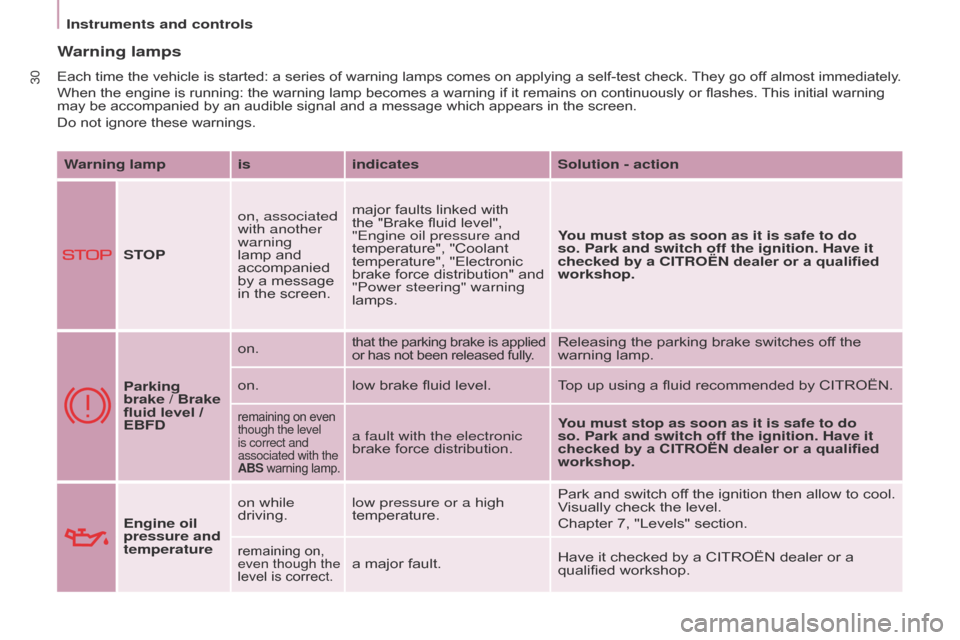
Berlingo_2_VP_en_Chap03_Pret-a-partir_ed02-2014
30
Warning lamps
Each time the vehicle is started: a series of warning lamps comes on applying a self-test check. They go off almost immediately.
When the engine is running: the warning lamp becomes a warning if it remains on continuously or flashes.
This
initial warning
may
be accompanied by an audible signal and a message which appears in the screen.
Do
not ignore these warnings.
Warning lamp is indicatesSolution - action
S t
OP on, associated
with another
warning
lamp
and
accompanied
by
a message
in
the screen.major
faults linked with
the
"Brake fluid level",
"Engine oil pressure and
temperature",
"Coolant
temperature",
"Electronic
brake
force distribution" and
"Power steering" warning
lamps.Y
ou must stop as soon as it is safe to do
so. Park and switch off the ignition. Have it
checked by a
c I tr OË n dealer or a qualified
workshop.
Parking
brake / Brake
fluid level /
EBF
d
on.that the parking brake is applied or
has not been released fully.Releasing the parking brake switches off the warning lamp.
on. low
brake
fluid
level. Top up using a fluid recommended by CITROËN.
remaining on even though the level
is correct and
associated with the
ABS
warning
lamp.
a fault with the electronic
brake force distribution. You must stop as soon as it is safe to do
so. Park and switch off the ignition. Have it
checked by a CITROËN dealer or a qualified
workshop.
Engine oil
pressure and
temperature on while
driving.
low pressure or a high
temperature. Park
and switch off the ignition then allow to cool.
V
isually check the level.
Chapter
7, "Levels" section.
remaining on, even though the
level is correct.a major fault. Have it checked by a CITROËN dealer or a qualified
workshop.
Instruments and controls
Page 43 of 276
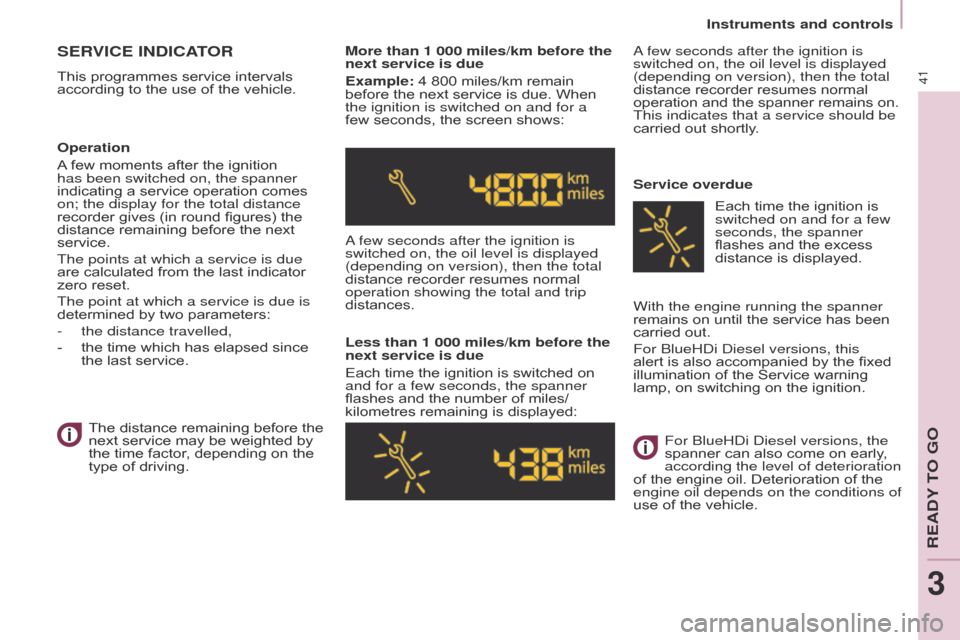
Berlingo_2_VP_en_Chap03_Pret-a-partir_ed02-2014
41
SErVIc E I nd I c AtO r
This programmes service intervals according
to the use of the vehicle.More than 1 000 miles/km before the
next service is due
Example:
4 800 miles/km remain
before
the next service is due. When
the ignition is switched on and for a
few
seconds, the screen shows:
a few seconds after the ignition is
switched on, the oil level is displayed
(depending on version), then the total
distance
recorder resumes normal
operation showing the total and trip
distances.
Less than 1 000 miles/km before the
next service is due
Each
time the ignition is switched on
and for a few seconds, the spanner
flashes
and the number of miles/
kilometres
remaining is displayed:
a few seconds after the ignition is
switched on, the oil level is displayed
(depending on version), then the total
distance
recorder resumes normal
operation
and the spanner remains on.
This indicates that a service should be
carried
out shortly.
Service overdue
Operation
A
few moments after the ignition
has been switched on, the spanner
indicating
a service operation comes
on; the display for the total distance
recorder
gives (in round figures) the
distance
remaining before the next
service.
The points at which a service is due
are
calculated from the last indicator
zero
reset.
The point at which a service is due is
determined
by two parameters:
-
the distance travelled,
-
the
time which has elapsed since
the
last service.
The
distance remaining before the
next
service may be weighted by
the
time factor, depending on the
type
of driving. With the engine running the spanner
remains
on until the service has been
carried
out.
For BlueH
d i d iesel versions, this
alert
is also accompanied by the fixed
illu
mination of the Service warning
lamp,
on switching on the ignition.
Each
time the ignition is
switched on and for a few
seconds, the spanner
flashes
and the excess
distance
is displayed.
For BlueH
d i d iesel versions, the
spanner
can also come on early,
according the level of deterioration
of
the engine oil. Deterioration of the
engine oil depends on the conditions of
use
of the vehicle.
Instruments and controls
REadY To Go
3
Page 44 of 276
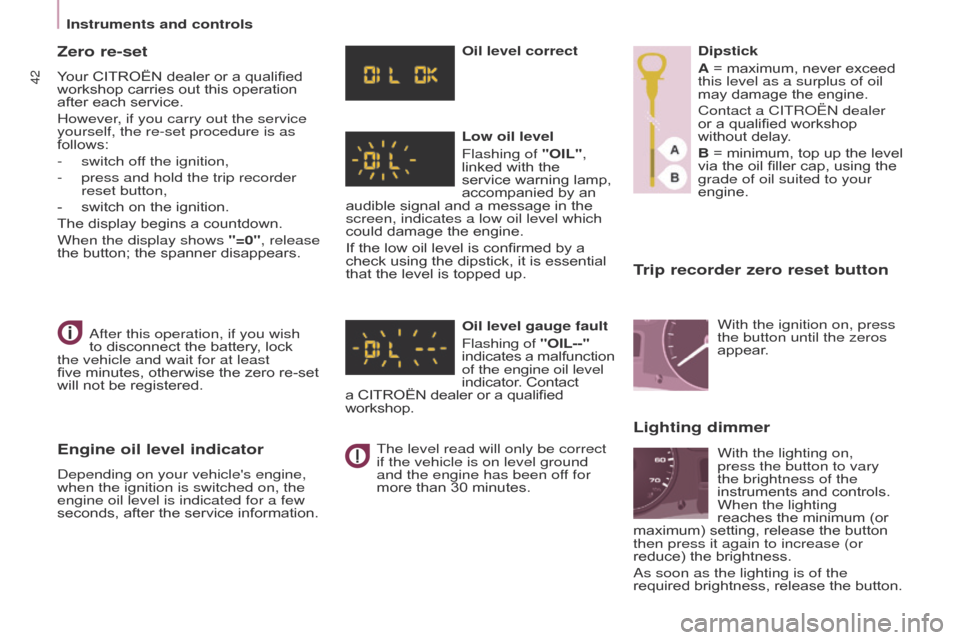
Berlingo_2_VP_en_Chap03_Pret-a-partir_ed02-2014
42
trip recorder zero reset button
after this operation, if you wish
to disconnect the battery, lock
the vehicle and wait for at least
five minutes,
otherwise the zero re-set
will
not be registered.
Engine oil level indicator
depending on your vehicle's engine,
when the ignition is switched on, the
engine oil level is indicated for a few
seconds,
after the service information. Oil level correct
Low oil level
Flashing of "OIL",
linked
with the
service
warning lamp,
accompanied
by an
audible
signal and a message in the
screen, indicates a low oil level which
could
damage the engine.
If the low oil level is confirmed by a
check
using the dipstick, it is essential
that
the level is topped up.
Oil level gauge fault
Flashing of "OIL--"
indicates
a
malfunction of the engine oil level
indicator. Contact
a
CITROËN dealer or a qualified
workshop.
The level read will only be correct
if the vehicle is on level ground
and the engine has been of
f for
more
than 30 minutes.
d
ipstick
A = maximum, never exceed
this level as a surplus of oil
may
damage the engine.
Contact a CITR o Ë n dealer
or a qualified workshop
without
delay.
B
=
minimum,
top
up
the
level
via
the oil filler cap, using the
grade of oil suited to your
engine.
Lighting dimmer
With the ignition on, press
the button until the zeros
appear.
With the lighting on,
press the button to vary
the brightness of the
instruments
and controls.
When the lighting
reaches
the minimum (or
maximum)
setting, release the button
then press it again to increase (or
reduce)
the
brightness.
a
s soon as the lighting is of the
required
brightness, release the button.
Zero re-set
Your CITROËN dealer or a qualified workshop carries out this operation
after
each service.
However, if you carry out the service
yourself, the re-set procedure is as
follows:
-
switch of
f the ignition,
-
press and hold the trip recorder
reset button,
-
switch
on the ignition.
The
display begins a countdown.
When the display shows "=0", release
the
button; the spanner disappears.
Instruments and controls
Page 111 of 276

ABS
ABS
109
Berlingo_2_VP_en_Chap05_Securite_ed02-2014
AntI-LOcK BrAKInG SYStEM
(ABS - EBF d )
The ABS and EBFD (electronic brake force
distribution) systems improve the
stability
and manoeuvrability of your
vehicle
on braking, in particular on
poor
or slippery surfaces.
The
ABS
prevents locking of the
wheels, the EBF
d provides control of
the
braking pressure wheel by wheel.If
this warning lamp comes on,
accompanied by an
audible
signal and a message
in the screen, it indicates a
malfunction
of the
ABS
which
could result in a loss of control of the
vehicle
on braking.
If
this warning lamp comes
on,
together with the brake
and
STOP
warning lamps,
accompanied
by an audible
signal
and a message in the
screen,
it indicates a malfunction of
the
electronic brake force distribution
which could result in a loss of control of
the
vehicle on braking.
EMErGEncY BrAKInG
ASSIS t
A
nc E SYS t EM (EBA)
In an emergency, this system enables the optimum braking pressure to be
reached
more quickly, press the pedal
firmly
without releasing it.
It is triggered by the speed at which the
brake
pedal is activated.
This
alters the resistance of the brake
pedal
under your foot.
To prolong the operation of the
emergency
braking assistance system:
keep
your foot on the brake pedal.
Good practice
The anti-lock braking system comes into operation automatically when
there
is a risk of wheel lock. It does not
reduce
the braking distance.
o
n very slippery surfaces (ice, oil,
etc...)
the
ABS
may increase the
braking
distance. When braking in
an
emergency, do not hesitate to
press
the brake pedal firmly, without
releasing the pressure, even on a
slippery surface, you will then be able
to
continue to manoeuvre the vehicle
to
avoid an obstacle.
Normal
operation of the
ABS
may be
felt
by slight vibration of the brake
pedal.
When changing wheels (tyres
and
rims), ensure that these are
recommended
by CITROËN. Stop as soon as it is safe to do so.
In both cases, contact a CITR
o Ë n
dealer
or a qualified workshop.
driving safely
SaFETY
5
Page 140 of 276

Berlingo_2_VP_en_Chap06_Accessoire_ed02-2014
138
The fitting of electrical equipment or accessories which are not
recommended by CITROËN may
result in a failure of your vehicle's
electronic
system. Please note this
specific
warning.
Y
ou are advised
to contact a dealer to be shown the
range
of recommended equipment or
accessories.
d
epending on the country in which
the
vehicle is sold, it is compulsory
to have a high visibility vest, warning
triangle and spare bulbs available in
the
vehicle. "Active Fleet
d ata" telematic unit
Connected directly to the heart of the
vehicle
(multiplexed network: "Full
CAN"),
the telematic unit, by means of
a
"ready to use" service, permits the
sending
in real time of information
such
as:
-
distance travelled,
-
distance
remaining before the next
service,
-
warnings and faults (oil level,
coolant
level, oil temperature,
coolant
temperature, etc...).
This
enables "Fleet" managers
to
optimise the monitoring and
management
of their professional
vehicles.
d
epending on country, contact a
CITROËN dealer
for more information.
Equipment
Page 143 of 276
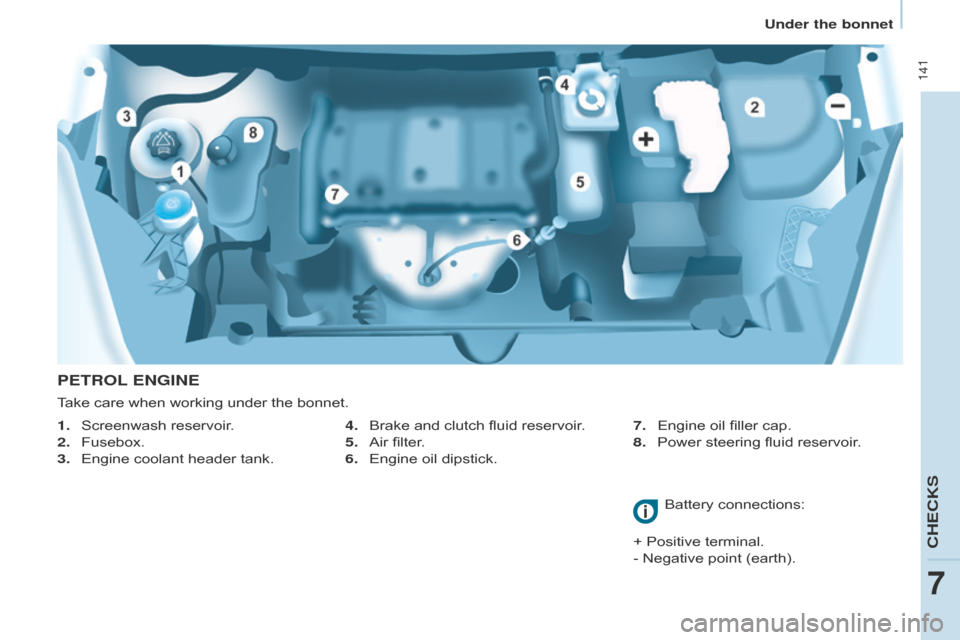
Berlingo_2_VP_en_Chap07_Verification_ed02-2014
141
PEtrOL EnGInE
1. Screenwash reservoir.
2.
Fusebox.
3.
Engine
coolant header tank.
Battery
connections:
+
Positive terminal.
-
Negative point (earth).
Take
care when working under the bonnet.
4. Brake and clutch fluid reservoir.
5.
Air
filter.
6.
Engine
oil dipstick.7.
Engine oil filler cap.
8.
Power
steering fluid reservoir.
Under the bonnet
CHECkS
7
Page 144 of 276

Berlingo_2_VP_en_Chap07_Verification_ed02-2014
142
dIESEL EnGInE
4. Brake and clutch fluid reservoir.
5.
Air
filter.
6.
Engine
oil dipstick. 7.
Engine oil filler cap.
8.
Power
steering fluid reservoir.
9.
Priming
pump.
1.
Screenwash
reservoir.
2.
Fusebox.
3.
Engine
coolant
header
tank.
Battery
connections:
+
Positive terminal.
-
Negative point (earth).
Take
care
when
working
under
the
bonnet.
Under the bonnet